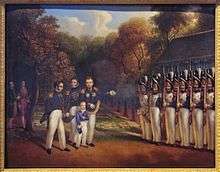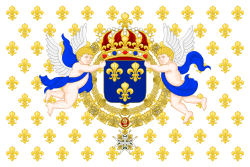Henri, Count of Chambord
Prince Henri, Count of Chambord (French: Henri Charles Ferdinand Marie Dieudonné d'Artois, duc de Bordeaux, comte de Chambord; 29 September 1820 – 24 August 1883)[1] was disputedly King of France from 2 to 9 August 1830 as Henry V, although he was never officially proclaimed as such. Afterwards, he was the Legitimist pretender to the throne of France from 1844 until his death in 1883.
| Henri | |||||
|---|---|---|---|---|---|
| Count of Chambord | |||||
 | |||||
| King of France (disputed) as Henry V | |||||
| Reign | 2 – 9 August 1830 (Unproclaimed) | ||||
| Predecessor | Charles X Louis XIX (unproclaimed) | ||||
| Successor | Louis Philippe I as King of the French | ||||
| Legitimist pretender to the French throne | |||||
| Pretendence | 3 June 1844 – 24 August 1883 | ||||
| Predecessor | Louis XIX | ||||
| Successor | Legitimist division: | ||||
| Born | 29 September 1820 Tuileries Palace, Paris, Kingdom of France | ||||
| Died | 24 August 1883 (aged 62) Schloss Frohsdorf, Frohsdorf, Austria-Hungary | ||||
| Burial | |||||
| Spouse | |||||
| |||||
| House | Bourbon | ||||
| Father | Prince Charles Ferdinand, Duke of Berry | ||||
| Mother | Princess Carolina of Naples and Sicily | ||||
| Religion | Roman Catholicism | ||||
Henri was the only son of Charles Ferdinand, Duke of Berry, born after his father's death. The Duke was the younger son of Charles X of France, by his wife, Princess Carolina of Naples and Sicily, daughter of King Francis I of the Two Sicilies. As the grandson of Charles X, Henri was a Petit-Fils de France. He was the last legitimate descendant in the senior male line of Louis XV of France.
Early life

Henri d'Artois was born on 29 September 1820, in the Pavillon de Marsan, a portion of the Tuileries Palace that still survives in the compound of the Louvre Palace in Paris. His father, the duc de Berry, had been assassinated seven months before his birth.
At birth, Henri was given the title of duc de Bordeaux. Because of his birth after his father's death, when the senior male line of the House of Bourbon was on the verge of extinction, Henri was named Dieudonné ("God-given"). Royalists called him "the miracle child". Louis XVIII was overjoyed, bestowing 35 royal orders to mark the occasion. Henri's birth was a major setback for Duke of Orleans' ambitions to ascend the French throne. During his customary visit to congratulate the newborn's mother, the duke made such offensive remarks about the baby's appearance that the lady holding him was brought to tears.[2]
Pretender monarch

On 2 August 1830, in response to the July Revolution, Henri's grandfather, Charles X, abdicated, and twenty minutes later Charles' elder son Louis Antoine, duc d'Angoulême, himself renounced his rights, in favour of the young duc de Bordeaux. Charles X urged his cousin Louis Philippe of Orléans, as Lieutenant général du royaume, to proclaim Henri as Henry V, King of France. Louis Philippe requested the duc de Bordeaux to be brought in Paris to have his rights recognized. The duchess of Berry was denied to escort her son, therefore both the grand-father and the mother refused to leave the child in France [4]. As a consequence, after seven days, a period in which legitimist monarchists considered that Henri had been the rightful monarch of France, the National Assembly decreed that the throne should pass to Louis Philippe, who was proclaimed King of the French on 9 August.[5]
Henri and his family left France and went into exile on 16 August 1830. While some French monarchists recognized him as their sovereign, others disputed the validity of the abdications of his grandfather and of his uncle. Still others recognised the July Monarchy of Louis Philippe. With the death of his 79-year-old grandfather in 1836 and of his uncle in 1844, young Henri became the genealogically senior claimant to the French throne. His supporters were called Legitimists to distinguish them from the Orléanists, the supporters of the family of Louis Philippe.
Henri, who preferred the courtesy title of comte de Chambord (from the château de Chambord, which had been presented to him by the Restoration government, and which was the only significant piece of personal property of which he was allowed to retain ownership upon his exile), continued his claim to the throne throughout the July Monarchy of Louis Philippe, the Second Republic, the Second Empire of Napoléon III, and the Third Republic.
In November 1846, the comte de Chambord married his second cousin Archduchess Maria Theresa of Austria-Este, daughter of Duke Francis IV of Modena and Princess Maria Beatrice of Savoy. The couple had no children.
Hope
.jpg)
.svg.png)
In the early 1870s, as the Second Empire collapsed following its defeat in the Franco-Prussian War at the battle of Sedan on 1 September 1870, the royalists became a majority in the National Assembly. The Orléanists agreed to support the aging comte de Chambord's claim to the throne, with the expectation that at his childless death he would be succeeded by their own claimant, Philippe d'Orléans, comte de Paris. Henri was then pretender for both Legitimists and Orléanists, and the restoration of monarchy in France seemed a close possibility. However, Henri insisted that he would accept the crown only on condition that France abandon its tricolour flag and return to the use of the white fleur de lys flag.[7] He rejected a compromise, whereby the fleur-de-lys would be the new king's personal standard, and the tricolour would remain the national flag.
Defeat
A temporary Third Republic was established, to wait for Henri's death and his replacement by the more liberal Comte de Paris. By the time this occurred in 1883, public opinion had however swung behind the Republic as the form of government which, in the words of the former President Adolphe Thiers, "divides us least". Thus, Henri could be mockingly hailed by republicans such as Georges Clemenceau as "the French Washington" — the one man without whom the Republic could not have been founded.
Henri died on 24 August 1883 at his residence in Frohsdorf, Austria, at the age of sixty-two, bringing the Louis XV male-only line to an end. He was buried in his grandfather Charles X's crypt in the church of the Franciscan Kostanjevica Monastery in Gorizia, then Austria, now in Slovenian city of Nova Gorica. His personal property, including the château de Chambord, was left to his nephew, Robert I, Duke of Parma (son of Henri's late sister).
Henri's death left the Legitimist line of succession distinctly confused. On one hand, Henri himself had accepted that the head of the Maison de France (as distinguished from the Maison de Bourbon) would be the head of the Orléans line, i.e. the Comte de Paris. This was accepted by many Legitimists, and was the default on legal grounds; the only surviving Bourbon line more senior was the Spanish branch, which had renounced its right to inherit the throne of France as a condition of the Treaty of Utrecht. However, many if not most of Henri's supporters, including his widow, chose to disregard his statements and this law, arguing that no one had the right to deny to the senior direct-male-line male Bourbon to be the head of the Maison de France and thus the legitimate King of France; the renunciation of the Spanish branch is under this interpretation illegitimate and therefore void. Thus these Legitimists settled on Juan, Count of Montizón, the Carlist pretender to the Spanish throne (the Salic law having been suspended in Spain, the actual king, Alfonso XII, was not the senior descendant in the male line), as their claimant to the French crown.
Gallery
 The Duchess of Berry and her children by François Gérard, 1822
The Duchess of Berry and her children by François Gérard, 1822 The young Duke of Bordeaux in a military uniform, by Alexandre-Jean Dubois-Drahonet, 1828
The young Duke of Bordeaux in a military uniform, by Alexandre-Jean Dubois-Drahonet, 1828.png) The Duchess of Berry and her son by François Gérard, 1828
The Duchess of Berry and her son by François Gérard, 1828 Detail of portrait, c.1830
Detail of portrait, c.1830 Portrait, c.1833
Portrait, c.1833
Honours

.svg.png)
Ancestry
| Ancestors of Henri V of France | |||||||||||||||||||||||||||||||||||||||||||||||||||||||||||||||||||||||||||||||||||||||||||||||||||||||||||||||||||||||||||||||||||||||||||||||||||||||||||||||||||||||||||||||||||||||||||||||||||||||||||||||||||||||||||||||||||||||||||||||||||||||||||||||||||||||||||||||||||||||||
|---|---|---|---|---|---|---|---|---|---|---|---|---|---|---|---|---|---|---|---|---|---|---|---|---|---|---|---|---|---|---|---|---|---|---|---|---|---|---|---|---|---|---|---|---|---|---|---|---|---|---|---|---|---|---|---|---|---|---|---|---|---|---|---|---|---|---|---|---|---|---|---|---|---|---|---|---|---|---|---|---|---|---|---|---|---|---|---|---|---|---|---|---|---|---|---|---|---|---|---|---|---|---|---|---|---|---|---|---|---|---|---|---|---|---|---|---|---|---|---|---|---|---|---|---|---|---|---|---|---|---|---|---|---|---|---|---|---|---|---|---|---|---|---|---|---|---|---|---|---|---|---|---|---|---|---|---|---|---|---|---|---|---|---|---|---|---|---|---|---|---|---|---|---|---|---|---|---|---|---|---|---|---|---|---|---|---|---|---|---|---|---|---|---|---|---|---|---|---|---|---|---|---|---|---|---|---|---|---|---|---|---|---|---|---|---|---|---|---|---|---|---|---|---|---|---|---|---|---|---|---|---|---|---|---|---|---|---|---|---|---|---|---|---|---|---|---|---|---|---|---|---|---|---|---|---|---|---|---|---|---|---|---|---|---|---|---|---|---|---|---|---|---|---|---|---|---|---|---|---|---|---|
| |||||||||||||||||||||||||||||||||||||||||||||||||||||||||||||||||||||||||||||||||||||||||||||||||||||||||||||||||||||||||||||||||||||||||||||||||||||||||||||||||||||||||||||||||||||||||||||||||||||||||||||||||||||||||||||||||||||||||||||||||||||||||||||||||||||||||||||||||||||||||
Patrilineal descent
| Patrilineal descent |
|---|
|
Henri's patriline is the line from which he is descended father to son. Patrilineal descent is the principle behind membership in royal houses, as it can be traced back through the generations - which means that if Henri were to choose an historically accurate house name it would be Robertian, as all his male-line ancestors have been of that house. Henri is a member of the House of Bourbon, a branch of the Capetian dynasty and of the Robertians. Henri's patriline is the line from which he is descended father to son. It follows the Bourbon, Kings of France, and the Counts of Paris and Worms. This line can be traced back more than 1,200 years from Robert of Hesbaye to the present day, through Kings of France & Navarre, Spain and Two-Sicilies, Dukes of Parma and Grand-Dukes of Luxembourg, Princes of Orléans and Emperors of Brazil. It is one of the oldest in Europe.
|
See also
Footnotes
- Chisholm, Hugh, ed. (1911). . Encyclopædia Britannica. 5 (11th ed.). Cambridge University Press. pp. 822–823.
- Bernard, J.F. (1973). Talleyrand: A Biography. New York: Putnam. p. 495. ISBN 0-399-11022-4.
- Castelot, André (1988). Charles X. Paris: Perrin. p. 492. ISBN 978-2-262-00545-0.
- GARNIER, J. (1968). LOUIS-PHILIPPE ET LE DUC DE BORDEAUX (avec des documents inédits). Revue Des Deux Mondes (1829-1971), 38-52. Retrieved May 26, 2020, from www.jstor.org/stable/44593301
- Price, Munro (2007). The Perilous Crown: France between Revolutions. London: Macmillan. pp. 177, 181–182, 185. ISBN 978-1-4050-4082-2.
- Smith, Whitney (1975). Flags: Through the Ages and Across the World. New York: McGraw-Hill. p. 75. ISBN 978-0-07-059093-9.
- D. W. Brogan, The Development of Modern France (1870-1939) (London: Hamish Hamilton, 1945), pp. 83-84.
- "Toison Espagnole (Spanish Fleece) - 19th century" (in French), Chevaliers de la Toison D'or. Retrieved 2018-09-05.
Further reading
- Brown, Marvin Luther. The Comte de Chambord :The Third Republic's Uncompromising King. Durham, N.C.:, Duke University Press, 1967.
- Delorme, Philippe. Henri, comte de Chambord, Journal (1846-1883), Carnets inédits. Paris: Guibert, 2009.
- "The Death of the comte de Chambord", British Medical Journal 2, no. 1186 (September 22, 1883): 600-01.
External links
| Wikimedia Commons has media related to Henri d'Artois, comte de Chambord. |
- Works by or about Henri, Count of Chambord at Internet Archive
- The Birth of the Duc de Bordeaux
- Obituary in The Times
Henri, Count of Chambord Cadet branch of the Capetian dynasty Born: 29 September 1820 Died: 24 August 1883 | ||
| Regnal titles | ||
|---|---|---|
| Preceded by Louis XIX (disputed) |
King of France (disputed) 2 – 9 August 1830 |
Succeeded by Louis Philippe as King of the French |
| Titles in pretence | ||
| Preceded by Louis XIX |
— TITULAR — King of France Legitimist pretender to the French throne 3 June 1844 – 24 August 1883 Reason for succession failure: July Revolution |
Succeeded by John III or Philip VII |
